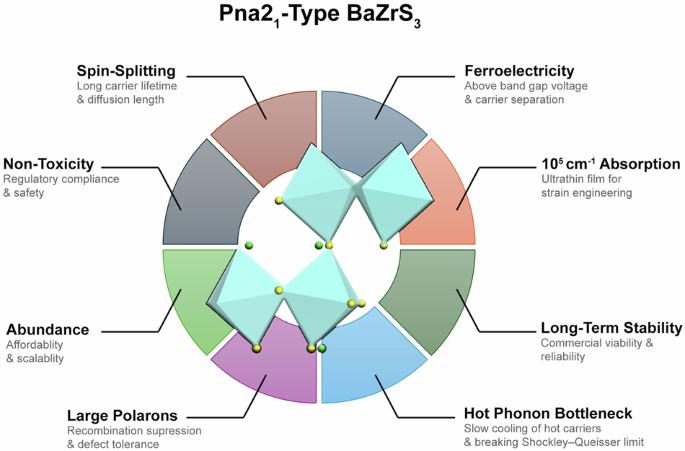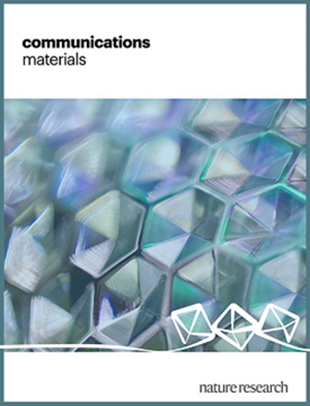光伏用应变BaZrS3硫系钙钛矿中的外来铁电性
IF 9.6
Q1 MATERIALS SCIENCE, MULTIDISCIPLINARY
引用次数: 0
摘要
太阳能电池中的铁电性被认为有许多好处,包括改善载流子分离和高于带隙器件电压,然而大多数铁电性是产生很少光电流的宽间隙材料。一些卤化物钙钛矿是铁电性的,但它们会受到降解的影响,尽管它们在其他方面具有优异的性能。近年来,硫系钙钛矿BaZrS3因其具有良好的带隙、无毒性和优异的稳定性而受到人们的关注。据报道,BaZrS3的基态是gdfeo3型扭曲钙钛矿(空间群Pnma)。在这里,使用第一性原理计算,我们表明极性Pna21在热力学上与Pnma一样稳定。这种新相是弱铁电相,净极化为0.27µC/cm2, d33压电系数仅为~1 pm/V。在应变作用下,面外和面内八面体倾角之间的相互作用放大了自发极化、自旋分裂和大极化子半径。这些奇异的特性可以与流行的卤化物钙钛矿相媲美。太阳能电池中的铁电性可以改善载流子的分离,并提供比带隙器件更高的电压。在这里,应变BaZrS3的第一性原理计算揭示了铁电性和类似于光伏应用的卤化物钙钛矿的奇异性质。本文章由计算机程序翻译,如有差异,请以英文原文为准。

Exotic ferroelectricity in strained BaZrS3 chalcogenide perovskite for photovoltaics
Ferroelectricity in solar cells is credited with a multitude of benefits, including improved charge carrier separation and higher than band gap device voltages, however most ferroelectrics are wide-gap materials that generate very little photocurrent. Some halide perovskites are ferroelectric, but they suffer from degradation, despite their otherwise excellent performance. Recently, BaZrS3, a chalcogenide perovskite has received attention due to its optimal band gap, non-toxicity, and superior stability. The ground state of BaZrS3 is reportedly a GdFeO3-type distorted perovskite (space group Pnma). Here, using first-principle calculations, we show that the polar Pna21 is thermodynamically as stable as Pnma. This new phase is weakly ferroelectric, exhibiting a net polarization of 0.27 µC/cm2 and a d33 piezoelectric coefficient of only ~1 pm/V. Under strain, the interplay between out-of-plane and in-plane octahedral tilts amplifies spontaneous polarization, spin splitting, and large polaron radii. These exotic traits are comparable to those of the popular halide perovskites. Ferroelectricity in solar cells can improve charge carrier separation and provide higher than bandgap device voltages. Here, first-principles calculations in strained BaZrS3 reveal ferroelectricity and exotic properties akin to halide perovskites for photovoltaics applications.
求助全文
通过发布文献求助,成功后即可免费获取论文全文。
去求助
来源期刊

Communications Materials
MATERIALS SCIENCE, MULTIDISCIPLINARY-
CiteScore
12.10
自引率
1.30%
发文量
85
审稿时长
17 weeks
期刊介绍:
Communications Materials, a selective open access journal within Nature Portfolio, is dedicated to publishing top-tier research, reviews, and commentary across all facets of materials science. The journal showcases significant advancements in specialized research areas, encompassing both fundamental and applied studies. Serving as an open access option for materials sciences, Communications Materials applies less stringent criteria for impact and significance compared to Nature-branded journals, including Nature Communications.
 求助内容:
求助内容: 应助结果提醒方式:
应助结果提醒方式:


